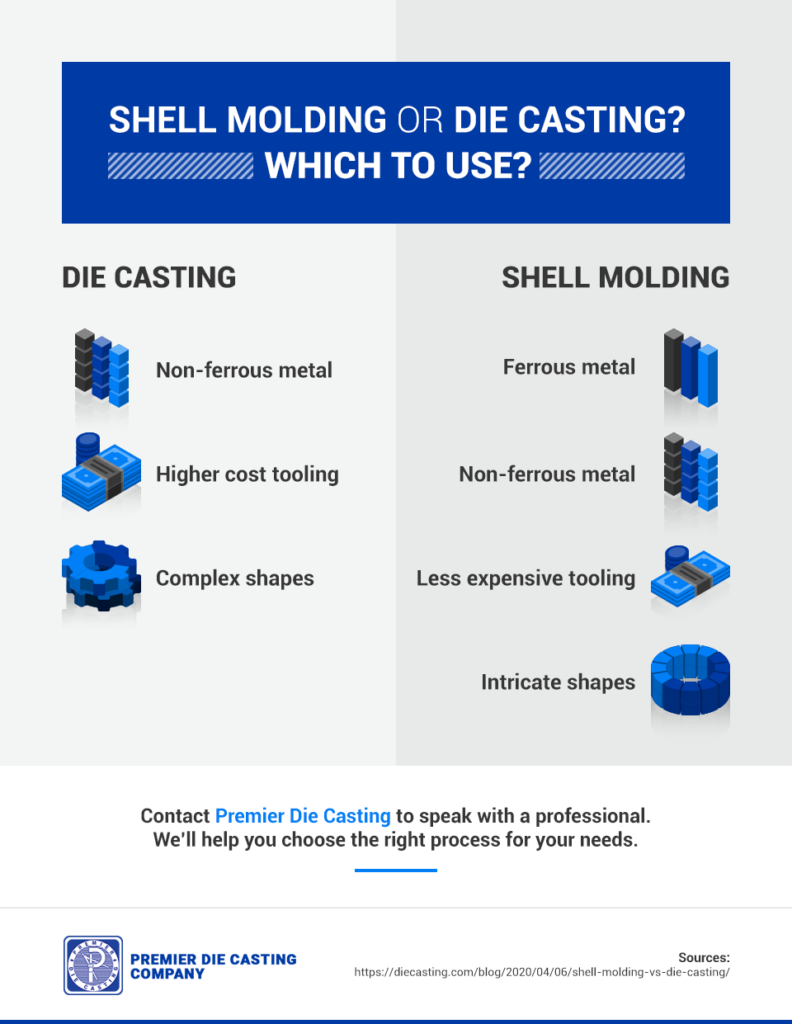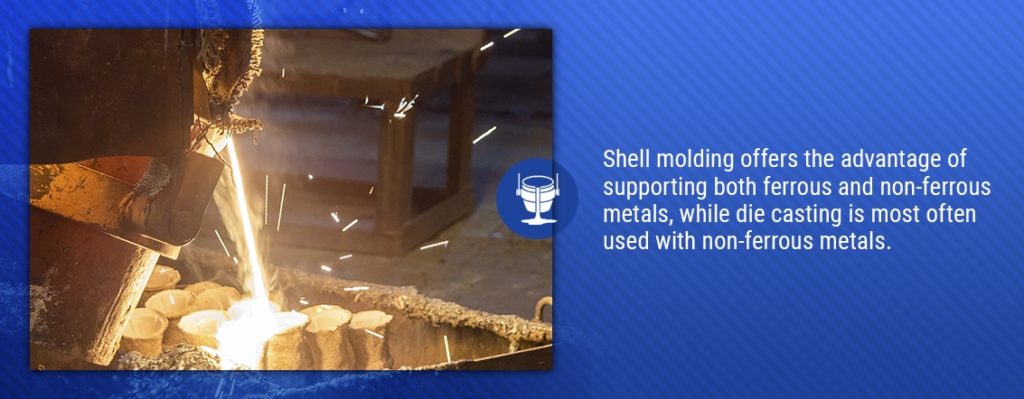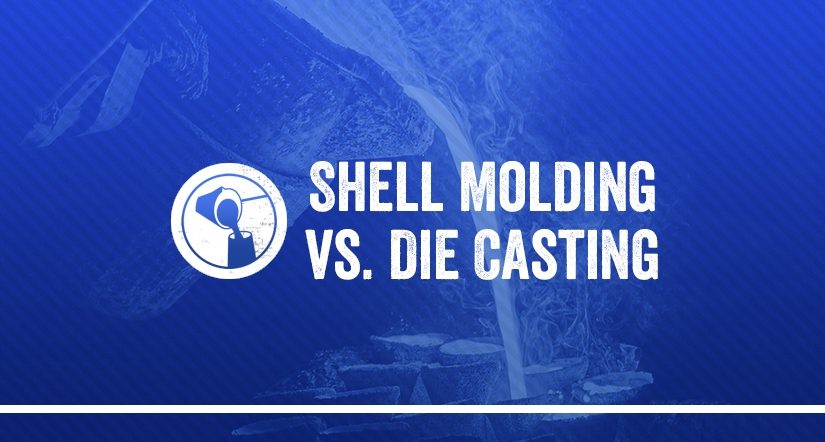Choosing the right manufacturing processes can feel overwhelming, as there are so many possible options. Two choices to consider are shell molding and die casting. Both of these processes have their advantages and can be used to produce various types of components.
So, what are the differences between these processes, and how do you know which one to choose for your project? In this guide, we’ll discuss how shell molding and die casting work and compare their applications and advantages.
What Is Shell Molding?
Shell molding is a process that involves the use of a sand-based mold. The mold is a shell with thin walls that is created by applying a mixture of sand and resin to a pattern, which is a metal object in the shape of the manufactured part. You can use this pattern to create multiple shell molds.
The Shell Molding Process
The shell molding process includes the following steps:
- Pattern creation: The first step is to create a metal pattern in the shape of the desired part. This two-piece pattern is typically made of steel or iron, but can also be made of aluminum, graphite or other materials.
- Mold creation: The pattern is first heated and lubricated to make removal easier. Then, it is attached to a dump box containing a mix of sand and resin. The dump box is then inverted, causing the sand and resin to coat the pattern. The mixture begins to cure because of the heated pattern and form a shell surrounding the pattern. When the curing process is finished, the shell is removed from the pattern.
- Mold assembly: The two halves of the shell are then clamped together, creating the complete mold. If cores are needed, they are put in place before closing the mold.
- Pouring: The mold is then clamped together, and the molten metal is poured through the gating system into the mold cavity.
- Cooling: Once the mold has filled, the metal is left to cool and solidify into the final casting shape.
- Casting removal: The mold is then broken, and the casting is removed. All excess metal and sand are then removed from the feed system and mold.
Shell Molding Applications
Shell molding can be used with both ferrous and non-ferrous metals and is most often used with carbon steel, stainless steel, alloy steel, cast iron, copper alloys and aluminum alloys. It is typically used to make small to medium-sized parts that require high dimensional accuracy and thin sections. Common parts made with shell molding include:
- Gear housings
- Connecting rods
- Cylinder rods
- Lever arms
- Truck hoods
- Body panes
- Bathtubs
- Drum shells

Advantages of Shell Molding
Shell molding offers various benefits, including it:
- Allows you to create intricate shapes accurately.
- Has minimal labor requirements.
- Supports various kinds of metals.
- Can be scaled for mass production.
What Is Die Casting?
Die casting is a manufacturing process that can be used to produce a wide variety of metal parts. It involves forcing molten metal that is under high pressure into a steel mold, called a die, that is in the shape of the manufactured product. The metal dies are reusable. You can use various metals, but often, alloy metals, such as aluminum, zinc or copper, are used. Gravity die casting refers to die casting using only gravity for pouring metal into the mold, rather than pressure.
There are several methods used for injecting molten metal into dies as part of the die casting process:
- The hot chamber process utilizes machines that are used for low-melting metals, such as zinc and some magnesium alloys. The process involves the use of a furnace containing a molten metal bath. The hot chamber machine is attached to the furnace by a metal feeding system.
- The cold chamber process involves pouring molten metal into the chamber using a ladle. A hydraulic plunger then seals the cold chamber and pushes the metal through into the die cavity. The cold chamber method is typically used for metals with high melting points.
The Die Casting Process
While the casting process differs slightly, depending on whether the hot chamber or cold chamber method is used, both methods follow similar steps. The process is extremely fast – in the range of a few seconds. The steps include:
- Clamping: Dies consisting of two halves are created to match the shape of the item being manufactured. Once these dies are made, they must be cleaned and lubricated. They are then closed and clamped securely together.
- Injection: Next, the molten metal is injected into the die using either the hot or cold chamber method. The size and complexity of the piece, as well as the wall thickness, influence how long the injection process will take.
- Cooling: Once the mold is filled, it is left to cool. The dies must be closed until the cooling process is complete. The molten metal solidifies, creating the final casting shape.
- Ejection: Once the metal has cooled, the die halves can be unclamped, and the casting can be removed from the die cavity.
- Trimming: Any excess material is then removed from the die, sometimes with the help of a tool, such as a saw or trimming press.
If desired, the die halves can then be clamped shut again, so another piece can be manufactured.
Die Casting Applications
Die casting is used mostly with non-ferrous metals. You can use it to produce objects of various sizes and shapes, including extremely intricate designs and designs with both smooth and textured surfaces. The process can produce castings to very tight tolerances.
Advantages of Die Casting
There are several benefits of using die casting, including it:
- Has the ability to create complex shapes.
- Produces castings to tight tolerances.
- Has the ability to create parts with variable wall thicknesses.
- Offers fast production cycle times.
- Creates minimal material scrap.
Die Casting or Shell Molding?

Both shell molding and die casting can produce various types of intricately shaped products quickly and can be scaled to produce large amounts of products.
Shell molding offers the advantage of supporting both ferrous and non-ferrous metals, while die casting is most often used with non-ferrous metals. If you need to use a ferrous metal, such as steel or iron, shell molding may be the right choice. Die casting, however, produces less waste because it does not require the use of sand and resin. The equipment costs and tooling costs for die casting are typically higher than those associated with shell modling.
Both shell molding and die casting are reliable processes that can be used to create accurate, high-quality parts. The best way to know which one is right for your project is to talk with a professional. They can review the details of your project and help you determine the ideal processes to use.
Contact Premier Engineered Products
Premier Engineered Products offers die casting, CNC machining, metal finishing, assembly and more. We’re based in the U.S. and have been in the industry for more than 70 years. Contact us and tell us about your project and goals, and we’ll help you choose the right processes for your needs.




